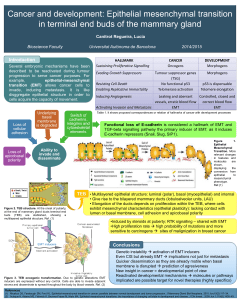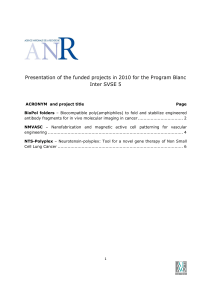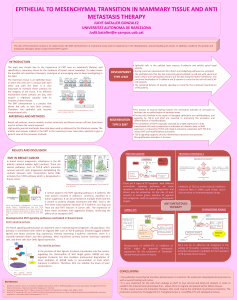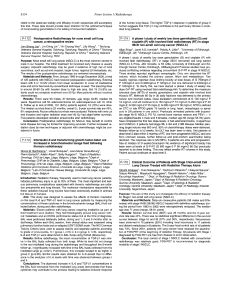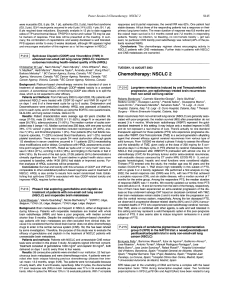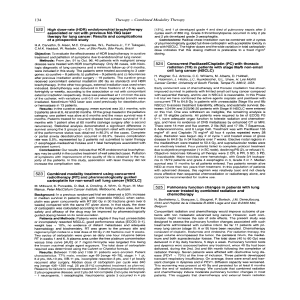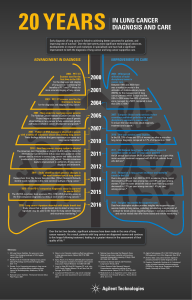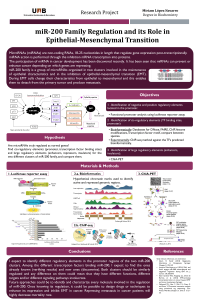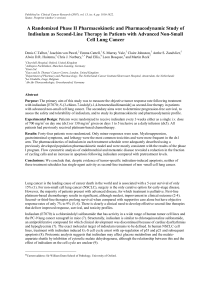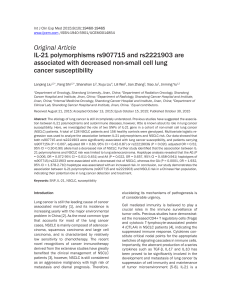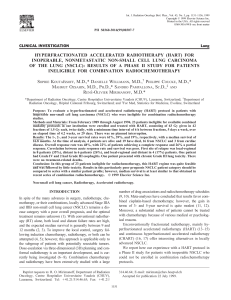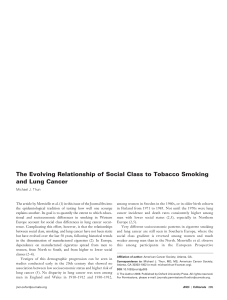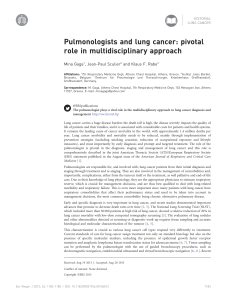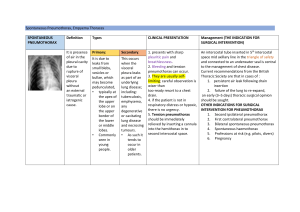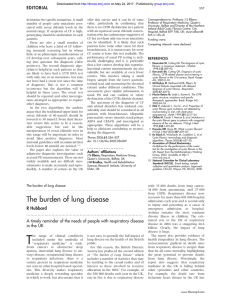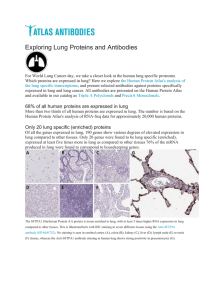Epithelial-Mesenchymal Transition in Non-Small Cell Lung Cancer
publicité
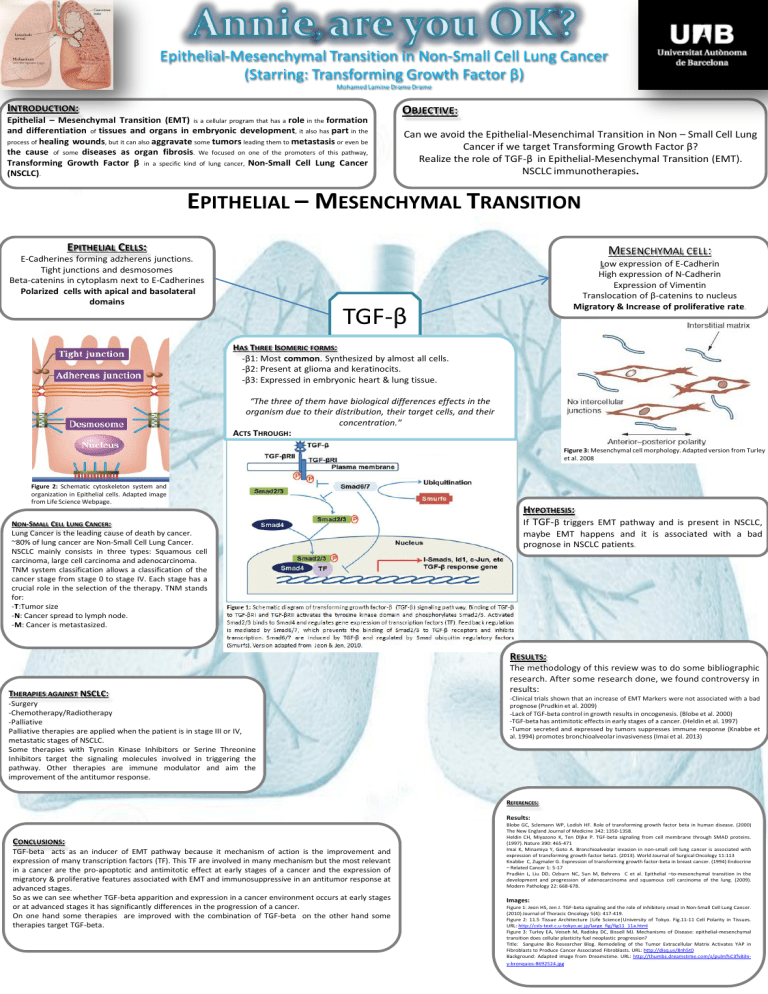
Epithelial-Mesenchymal Transition in Non-Small Cell Lung Cancer (Starring: Transforming Growth Factor β) Mohamed Lamine Drame Drame INTRODUCTION: Epithelial – Mesenchymal Transition (EMT) is a cellular program that has a role in the formation and differentiation of tissues and organs in embryonic development, it also has part in the process of healing wounds, but it can also aggravate some tumors leading them to metastasis or even be the cause of some diseases as organ fibrosis. We focused on one of the promoters of this pathway, Transforming Growth Factor β in a specific kind of lung cancer, Non-Small Cell Lung Cancer (NSCLC). OBJECTIVE: Can we avoid the Epithelial-Mesenchimal Transition in Non – Small Cell Lung Cancer if we target Transforming Growth Factor β? Realize the role of TGF-β in Epithelial-Mesenchymal Transition (EMT). NSCLC immunotherapies. EPITHELIAL – MESENCHYMAL TRANSITION EPITHELIAL CELLS: E-Cadherines forming adzherens junctions. Tight junctions and desmosomes Beta-catenins in cytoplasm next to E-Cadherines Polarized cells with apical and basolateral domains MESENCHYMAL CELL: Low expression of E-Cadherin High expression of N-Cadherin Expression of Vimentin Translocation of β-catenins to nucleus Migratory & Increase of proliferative rate. TGF-β HAS THREE ISOMERIC FORMS: -β1: Most common. Synthesized by almost all cells. -β2: Present at glioma and keratinocits. -β3: Expressed in embryonic heart & lung tissue. “The three of them have biological differences effects in the organism due to their distribution, their target cells, and their concentration.” ACTS THROUGH: Figure 3: Mesenchymal cell morphology. Adapted version from Turley et al. 2008 Figure 2: Schematic cytoskeleton system and organization in Epithelial cells. Adapted image from Life Science Webpage. NON-SMALL CELL LUNG CANCER: Lung Cancer is the leading cause of death by cancer. ~80% of lung cancer are Non-Small Cell Lung Cancer. NSCLC mainly consists in three types: Squamous cell carcinoma, large cell carcinoma and adenocarcinoma. TNM system classification allows a classification of the cancer stage from stage 0 to stage IV. Each stage has a crucial role in the selection of the therapy. TNM stands for: -T:Tumor size -N: Cancer spread to lymph node. -M: Cancer is metastasized. HYPOTHESIS: If TGF-β triggers EMT pathway and is present in NSCLC, maybe EMT happens and it is associated with a bad prognose in NSCLC patients. RESULTS: THERAPIES AGAINST NSCLC: -Surgery -Chemotherapy/Radiotherapy -Palliative Palliative therapies are applied when the patient is in stage III or IV, metastatic stages of NSCLC. Some therapies with Tyrosin Kinase Inhibitors or Serine Threonine Inhibitors target the signaling molecules involved in triggering the pathway. Other therapies are immune modulator and aim the improvement of the antitumor response. The methodology of this review was to do some bibliographic research. After some research done, we found controversy in results: -Clinical trials shown that an increase of EMT Markers were not associated with a bad prognose (Prudkin et al. 2009) -Lack of TGF-beta control in growth results in oncogenesis. (Blobe et al. 2000) -TGF-beta has antimitotic effects in early stages of a cancer. (Heldin et al. 1997) -Tumor secreted and expressed by tumors suppresses immune response (Knabbe et al. 1994) promotes bronchioalveolar invasiveness (Imai et al. 2013) REFERENCES: Results: CONCLUSIONS: TGF-beta acts as an inducer of EMT pathway because it mechanism of action is the improvement and expression of many transcription factors (TF). This TF are involved in many mechanism but the most relevant in a cancer are the pro-apoptotic and antimitotic effect at early stages of a cancer and the expression of migratory & proliferative features associated with EMT and immunosuppressive in an antitumor response at advanced stages. So as we can see whether TGF-beta apparition and expression in a cancer environment occurs at early stages or at advanced stages it has significantly differences in the progression of a cancer. On one hand some therapies are improved with the combination of TGF-beta on the other hand some therapies target TGF-beta. Blobe GC, Sclemann WP, Lodish HF. Role of transforming growth factor beta in human disease. (2000) The New England Journal of Medicine 342: 1350-1358. Heldin CH, Miyazono K, Ten Dljke P. TGF-beta signaling from cell membrane through SMAD proteins. (1997). Nature 390: 465-471 Imai K, Minamiya Y, Goto A. Bronchioalveolar invasion in non-small cell lung cancer is associated with expression of transforming growth factor beta1. (2013). World Journal of Surgical Oncology 11:113 Knabbe C, Zugmaler G. Expression of transforming growth factor-beta in breast cancer. (1994) Endocrine – Related Cancer 1: 5-17 Prudkin L, Liu DD, Ozburn NC, Sun M, Behrens C et al. Epithelial –to-mesenchymal transition in the development and progression of adenocarcinoma and squamous cell carcinoma of the lung. (2009). Modern Pathology 22: 668-678. Images: Figure 1: Jeon HS, Jen J. TGF-beta signaling and the role of inhibitory smad in Non-Small Cell Lung Cancer. (2010) Journal of Thoracic Oncology 5(4): 417-419. Figure 2: 11.5 Tissue Architecture |Life Science|University of Tokyo. Fig.11-11 Cell Polarity in Tissues. URL: http://csls-text.c.u-tokyo.ac.jp/large_fig/fig11_11a.html Figure 3: Turley EA, Veiseh M, Radisky DC, Bissell MJ. Mechanisms of Disease: epithelial-mesenchymal transition does cellular plasticity fuel neoplastic progression? Title: Sanguine Bio Researcher Blog. Remodeling of the Tumor Extracellular Matrix Activates YAP in Fibroblasts to Produce Cancer Associated Fibroblasts. URL: http://disq.us/8nh5t0 Background: Adapted image from Dreamstime. URL: http://thumbs.dreamstime.com/z/pulm%C3%B3ny-bronquios-8692524.jpg
